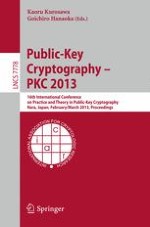2013 | OriginalPaper | Buchkapitel
Sequential Aggregate Signatures with Short Public Keys: Design, Analysis and Implementation Studies
verfasst von : Kwangsu Lee, Dong Hoon Lee, Moti Yung
Erschienen in: Public-Key Cryptography – PKC 2013
Verlag: Springer Berlin Heidelberg
Aktivieren Sie unsere intelligente Suche, um passende Fachinhalte oder Patente zu finden.
Wählen Sie Textabschnitte aus um mit Künstlicher Intelligenz passenden Patente zu finden. powered by
Markieren Sie Textabschnitte, um KI-gestützt weitere passende Inhalte zu finden. powered by
The notion of aggregate signature has been motivated by applications and it enables any user to compress different signatures signed by different signers on different messages into a short signature. Sequential aggregate signature, in turn, is a special kind of aggregate signature that only allows a signer to add his signature into an aggregate signature in sequential order. This latter scheme has applications in diversified settings, such as in reducing bandwidth of a certificate chains, and in secure routing protocols. Lu, Ostrovsky, Sahai, Shacham, and Waters presented the first sequential aggregate signature scheme in the standard (non idealized ROM) model. The size of their public key, however, is quite large (i.e., the number of group elements is proportional to the security parameter), and therefore they suggested as an open problem the construction of such a scheme with short keys. Schröder recently proposed a sequential aggregate signature (SAS) with short public keys using the Camenisch-Lysyanskaya signature scheme, but the security is only proven under an interactive assumption (which is considered a relaxed notion of security). In this paper, we propose the first sequential aggregate signature scheme with short public keys (i.e., a constant number of group elements) in prime order (asymmetric) bilinear groups which is secure under static assumptions in the standard model. Technically, we start with a public key signature scheme based on the recent dual system encryption technique of Lewko and Waters. This technique cannot give directly an aggregate signature scheme since, as we observed, additional elements should be published in the public key to support aggregation. Thus, our construction is a careful augmentation technique for the dual system technique to allow it to support a sequential aggregate signature scheme. We further implemented our scheme and conducted a performance study and implementation optimization.
